Topics 2019
December 2019
Dec. 6, 2019 Updated
GPM/DPR observed "Hot tower" in Typhoon Kammuri which hit Philippines
|
JAXA has been addressing global precipitation-related issues under the Global Precipitation Measurement (GPM) Mission by utilizing the 3D precipitation product "Dual-frequency Precipitation Radar (DPR)" onboard GPM core observatory and multi-satellite precipitation product "Global Satellite Mapping of Precipitation (GSMaP)". 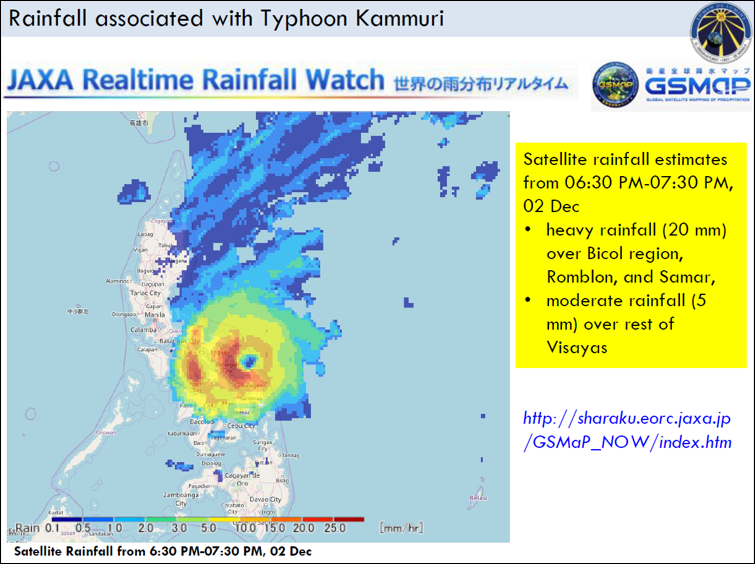
Fig.1 Typhoon Kammuri Report by Manila Observatory |
October 2019
Oct. 25, 2019 Updated
International Space Agencies Meet to Boost Coordination toward Moon-to-Mars Exploration
|
On October 3-4, 2019, senior managers met in Tokyo for a meeting of the International Space Exploration Coordination Group (ISECG), where JAXA had participated in this board. ISECG, which JAXA has been taking the Chair since 2018, is a coordination forum of 19 space agencies that aims to promote international space exploration. Summary of the ISECG Meeting in TokyoTOKYO – On October 3-4, 2019, senior managers representing 11 space agencies gathered at a meeting of the International Space Exploration Coordination Group (ISECG) with the purpose of promoting coordinated efforts toward human and robotic space exploration on and around the Moon and Mars. |
June 2019
Jun. 27, 2019 Updated
JAXA and CNES Sign Implementing Arrangement on Martian Moons eXploration (MMX) and Hayabusa2
|
Japan Aerospace Exploration Agency has agreed to cooperate with Centre National d'Etudes Spatiales (CNES) on the study-phase activities in JAXA’s Martian Moons eXploration(MMX) mission and analysis of Hayabusa2-returned samples. 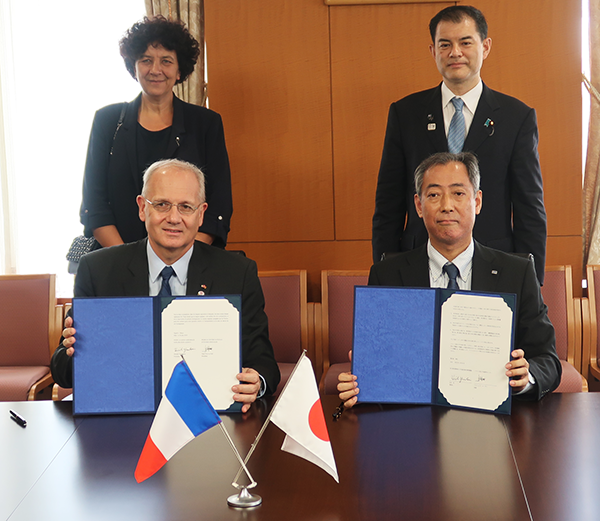

About the Implementing Arrangement concerning cooperative activities related to Martian Moon eXploration (MMX) mission studies
The MMX mission is planned to observe Mars’ two moons, Phobos and Deimos and to collect surface material from one of the moons to bring back to Earth. It aims to clarify the origin of the Martian moons and the process of evolution for Mars region and to improve technologies required for future exploration.
For more information on MMX, visit: About the Implementing Arrangement concerning cooperative activities related to analysis of Hayabusa2 return samples by MicrOmega at JAXA Extraterrestrial Sample Curation Center
Hayabusa2 is a successor of Hayabusa. By investigating the asteroid Ryugu(type-C asteroid)and collecting samples for return to Earth, it aims to clarify the origins and evolution of Earth as well as organic materials that formed the oceans and the life.
For more information on Hayabusa2, visit: |
Jun. 20, 2019 Updated
JAXA and DLR Make and Sign Implementing Arrangement on Martian Moons eXploration (MMX)
|
Japan Aerospace Exploration Agency has agreed to cooperate with German Aerospace Center (DLR) on the study-phase activities in JAXA's Martian Moons eXploration (MMX) mission. 
The MMX mission is planned to observe Mars' two moons, Phobos and Deimos and to collect surface material from one of the moons to bring back to Earth. It aims to clarify the origin of the Martian moons and the process of evolution for Mars region and to improve technologies required for future exploration. DLR will contribute to this mission by conducting studies of the rover which is to be equipped on MMX jointly with Centre National d'Etudes Spatiales (CNES) and by providing JAXA with opportunities of experiments using the Drop Tower in Germany. DLR will also support German scientists for their participation in the MMX mission. |
Jun. 17, 2019 Updated
Agreement with European Space Agency (ESA) for cooperation on the X-Ray Imaging and Spectroscopy Mission: XRISM
|
Japan Aerospace Exploration Agency has agreed to cooperate with European Space Agency (ESA) on the X-Ray Imaging and Spectroscopy Mission: XRISM. 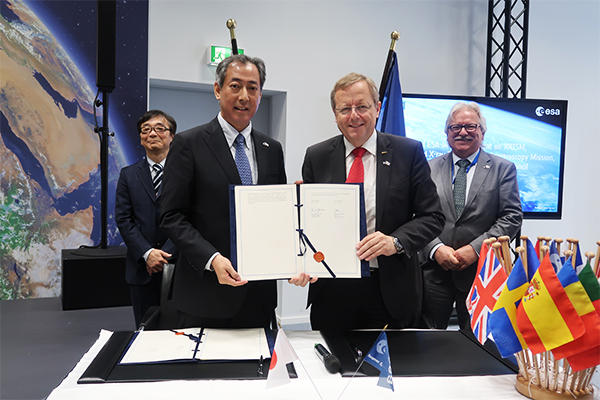
The XRISM project, kicked off in 2018, is the seventh X-ray astronomy satellite program of the Institute of Space and Astronautical Science, JAXA. It aims at the early recovery of the prime science objective "to solve outstanding astrophysical questions with high resolution X-ray spectroscopy" of ASTRO-H whose operation was ceased in 2016. |
April 2019
Apr. 23, 2019 Updated
CLASP2 Rocket Experiment Launched
|
The CLASP2 sounding rocket experiment launched on April 11, 2019 at 10:51 a.m. MDT (01:51 a.m. JST on April 12) from the White Sands Missile Range, New Mexico, USA. It reached 274 km at maximum altitude and observed the Sun for 6 minutes from above 160 km. After the observations, the instrument parachuted down to the White Sands Desert, and was carried back to the laboratory. All the data stored in the instrument were recovered successfully. 
CLASP2 Sounding Rocket launch. (credit: US Army Photo, White Sands Missile Range) |
March 2019
Mar. 26, 2019 Updated
UNOOSA and JAXA open Fifth Round of KiboCUBE!
|
Japan Aerospace Exploration Agency (JAXA) and the United Nations Office for Outer Space Affairs (UNOOSA) is pleased to announce the opening of the fifth round of KiboCUBE.
Please refer to the following website for further details regarding the applications for the KiboCUBE fifth round ("Announcement of Opportunity"). The application due date is September 30. We look forward to receiving many applicants and contributing to the capacity building of your country! Application details: (Reference 1) (Reference 2) Results of past selection 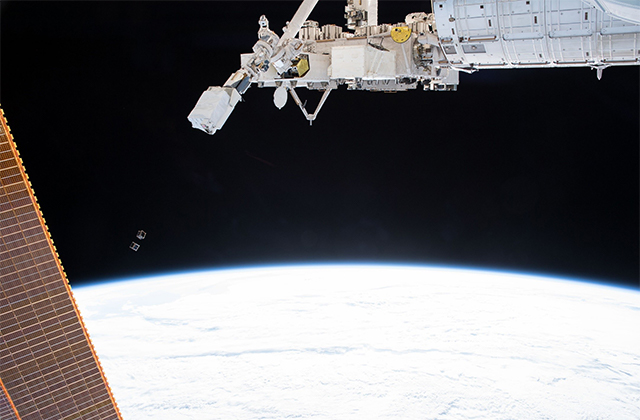
Successful deployment of 1KUNS-PF (Kenyan Satellite, selected as first round of KiboCUBE) from Kibo in May, 2018 |
||||||||||||||
Mar. 1, 2019 Updated
New Dataset Release: GCOM-C/SGLI
|
JAXA GCOM-C (Global Change Observation Mission - Climate "SHIKISAI") satellite was launched on Dec. 23rd, 2017 to conduct long-term and continuous global observations in order to elucidate the global warming mechanisms related to fluctuations in radiation budget and/or carbon cycles etc. 1. Events after the launch
The data was released as scheduled according to the following operations. 2. The overview of Initial calibration and validation operations
To detect tiny climate change signals, higher accuracy products are needed. JAXA performed calibration with GCOM-C function using solar light, internal lamps, black body, lunar light and others, and compared (calibration and validation) GCOM-C observation value with ground observation data acquired in cooperation with ground observation networks (Skynet, AERONET and AsiaFlux) and collaborating research institutes (universities, Meteorological Research Institute, JAMSTEC and NOAA). As a result of the calibration, JAXA confirmed that the accuracy of 29 types of products covering land, atmosphere, ocean and cryosphere is attained to start data utilization. 3. GCOM-C/SGCLI Standard Products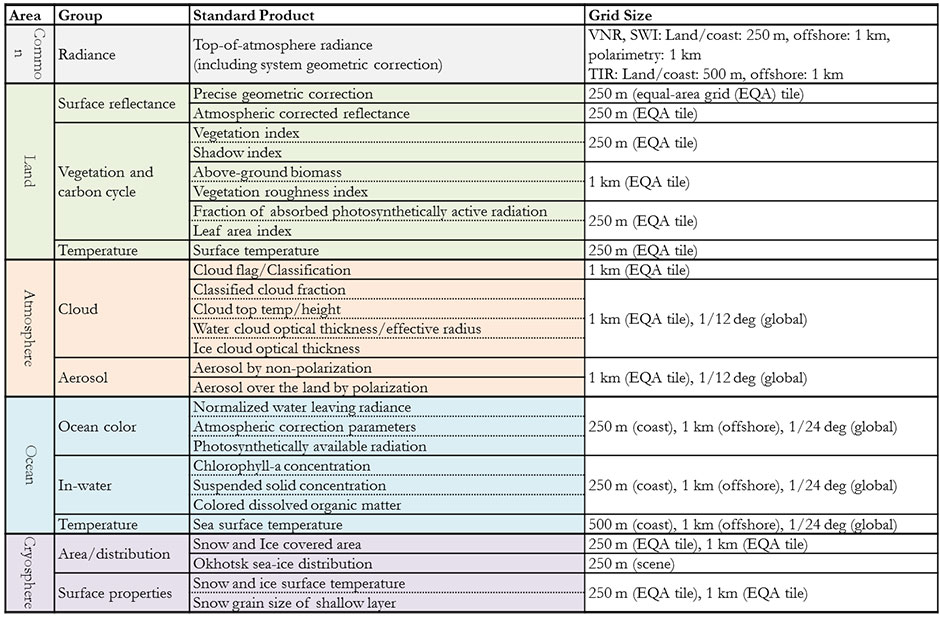
Further information for the definition of the product and sample data is available at; 1) Chlorophyll-a Concentration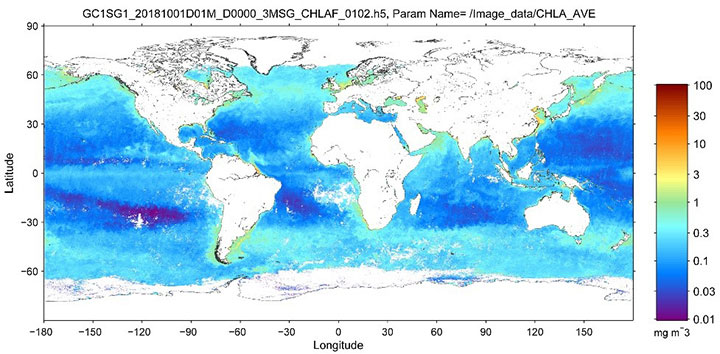
Global chlorophyll-a concentration (average of October 2018) 2) Aerosols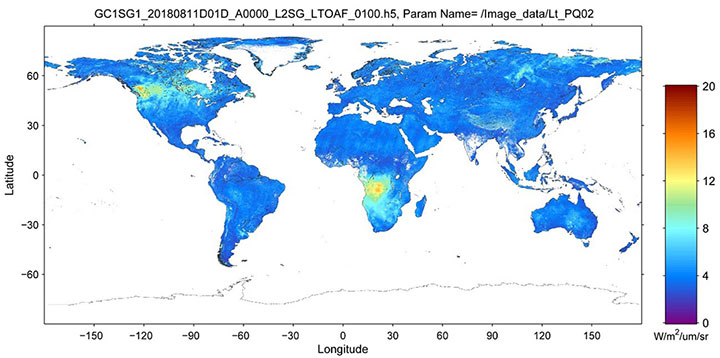
Polarization radiance at 867nm (average from August 11 to 20, 2018) 3) Global vegetation index (NDVI)The image is a map of global normalized difference vegetation index (NDVI) derived from SGLI observation data acquired during January 1st to 9th 2018. NDVI becomes high at active vegetation with high density, indicating the spatial distribution of vegetation on the global scale. 
|
February 2019
Feb. 25, 2019 Updated
[HAYABUSA2 PROJECT] Image from just after touchdown
|
From February 20 to 22, we conducted the touchdown operation (TD1-L8E1) of Hayabusa2 on the surface of asteroid Ryugu. Figure 1 shows an image taken with the Optical Navigation Camera – Wide angle (ONC-W1) during the spacecraft ascent after touchdown.
Figure 1: Image captured near the touchdown site immediately after touchdown. The photograph was taken with the Optical Navigation Camera – Wide angle (ONC-W1) on February 22, 2019 at an onboard time of around 07:30 JST. |
![[HAYABUSA2 PROJECT] Image from just after touchdown](https://global.jaxa.jp/news/images/topics_20190225_td1_w1image_e.jpg)
|
|---|
Feb. 20, 2019 Updated
H.E. Mr. William F. Hagerty, U.S. Ambassador to Japan, visited Tsukuba Space Center
|
H.E. Mr. William F. Hagerty, U.S. Ambassador to Japan, visited Tsukuba Space Center on February 15, 2019.

|
January 2019
Jan. 21, 2019 Updated
[HAYABUSA2 PROJECT] Locations on the surface of Ryugu have been named!
|
Place names for locations on the surface of Ryugu were discussed by Division F (Planetary Systems and Bioastronomy) of the International Astronomical Union (IAU) Working Group for Planetary System Nomenclature and approved in December 2018. We will introduce the place names and the background to their selection. |
![[HAYABUSA2 PROJECT] Locations on the surface of Ryugu have been named!](https://global.jaxa.jp/news/images/topics_20190121_Nomenclature_e.jpg)
|
|---|
Jan. 18, 2019 Updated
Successfully of Epsilon-4 Launch With The Innovative Satellite Technology Demonstoration-1 Aboard
|
At 9:50:20 a.m. (Japan Standard Time) January 18, 2019 JAXA launched Epsilon-4, the Fourth Epsilon launch vehicle With The Innovative Satellite Technology Demonstoration-1. From the JAXA Uchinoura Space Center. The launch occurred on time. The launch and flight of Epsilon-4 took place normally. Approximately 51 minutes 55 seconds into the flight, the separation of "The Innovative Satellite Technology Demonstoration-1" proceeded, with confirmation as successful. |

|
|---|
Jan. 16, 2019 Updated
The Innovative Satellite Technology Demonstoration-1 aboard Epsilon-4 launch time decided! Live broadcast from 9:25 a.m. on January 18 (Fri.)
|
The launch time of the Epsilon-4 with the Innovative Satellite Technology Demonstoration-1 was set for 9:50:20 a.m. on January 18 (Fri.), 2019 (Japan Standard Time.) |
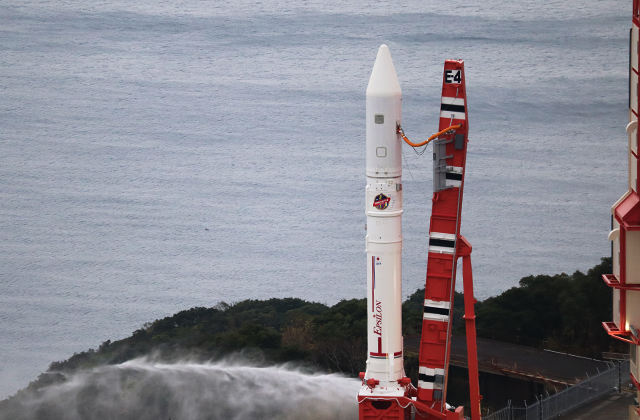
|
|---|
Jan. 15, 2019 Updated
The Innovative Satellite Technology Demonstoration-1 launch postponed to Jan. 17 (Fri., JST)
|
The Innovative Satellite Technology Demonstoration-1 launch postponed to Jan. 18 (Fri., JST) |

|
|---|
Updates 2019
-
- Jul. 18, 2019
- HTV8 media briefing at Tanegashima Space Center
-
- Jun. 24, 2019
- Four CubeSats successfully deployed from "Kibo"!
-
- Jun. 17, 2019
- Successful Deployment of SpooQy-1 from Kibo!
-
- Feb. 11, 2019
- Space Seeds for Asian Future 2013
-
- Jan. 30, 2019
- [JAXA Aeronautics Magazine] "FLIGHT PATH" No.22
-
- Jan. 9, 2019
- JAXA Astronaut Noguchi's Next ISS Mission Logo
